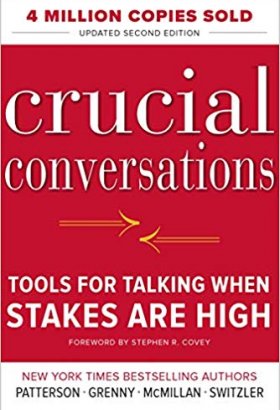You may also like

Creativity, Inc.
by Ed Catmull & Amy Wallace
The Five Dysfunctions of a Team
by Patrick Lencioni






by Patterson, Grenny, McMillan, and Switzler
“Crucial Conversations skills are only applicable if you live or work with or near other people,” writes one of the authors, a statement I wholly agree with. The authors didn’t set out to write a book on communication, but they definitely highlighted how difficult it can be and how important it is to overcome those hidden obstacles to get the results we need. I’m confident that these principles can help anyone through those difficult and highly impactful moments, described as crucial conversations, regardless of career and personal circumstances. It is often as simple as asking ourselves the right question at the right time.
Crucial Conversations gets better as you progress through the chapters. The earlier sections of the book outline the tools and the later parts identify how to use them; it’s worth re-reading every year to brush up on the principles, or at least the last couple of chapters. During my first reading of Crucial Conversations, I noticed I was participating in meetings differently and more productively. I’m confident this book can help almost anyone get better results in difficult situations.
What makes a crucial conversation? Three factors:
Why do we care? Evolution has given us a ‘fight or flight’ mentality. Emotions get the best of us and our actions lead to a self-fulfilling prophecy. In short, we often do our worst communicating when it matters most. Those of us that are able to manage our emotions and skillfully hold crucial conversations will not only have a step up in our careers, but we’ll lead more fulfilling lives.
We have all fallen victim to The Fool’s Choice, thinking that there are only two outcomes to a conversation. Those that are great at having crucial conversations know how to avoid The Fool’s Choice by being able to facilitate a safe dialogue. The more dialogue we have, the more information that can be shared. That collective information is something that the writers call, “The Pool of Shared Meaning.” The more information that we can add to the pool, the better our decisions will be.
The first step is correcting our assumption that other people are the root of our problems; we are rarely the innocent party in it all. The only person we really have control over is ourselves, so that’s where we should start. When beginning a high-risk conversation, start with the right motives and then stay focused on them. It can be very easy to lose that focus because of our desire to win (we just have to point out how other people are wrong and how we know all the answers) or keep the peace (we get so uncomfortable that we retreat into silence). Stay focused by asking yourself questions like “What do I really want? What do I really NOT want? Would someone that really wants these things be behaving like I am?” By taking a moment to ask yourself these simple questions, it allows our brain to recalibrate and turn to problem-solving mode rather than survival mode.
Noticing that you’re in a crucial conversation is the first major step. Keep an eye out for physical (e.g. stomach ache), emotional (e.g. anxiety, anger), or behavioral signs (e.g. raised voices).
Shortly after that, we have to focus on other whether everyone is feeling safe. The sooner we identify that people don’t feel safe to contribute to the conversation, the easier it is to get back to dialogue where true progress can be made. When we feel unsafe, we usually regress to silence or violence.
We MUST keep an eye out for these types of behaviors and refuse to give in to them. The authors provide a brief assessment to help identify which of the violence and silence mechanisms we succumb to.
If you build safety, you can talk about anything. When safety is threatened, we have to restore it by taking a step out of the moment. The problem is the nonexistence, or the perception thereof, of either mutual purpose or mutual respect.
Mutual purpose is often derailed by the perception of malicious intent. Because of that, the first action towards building mutual purpose is to help others see that we are working towards a common outcome. Not only should they care about your goal, you should care about theirs. Without these perceptions we’ll never be able to have a dialogue and add to the pool of meaning. Start by identifying your motives, then be empathetic and look at the conversation from their point of view. Both of these will help bring them into a sensitive conversation.
You can identify that mutual purpose is at risk if there is defensiveness, hidden agendas, frequent accusations, or often circling back to the same topics over and over.
Where mutual purpose is the starting point of a crucial conversation, mutual respect is what helps the conversation continue. Respect isn’t thought about when it’s there, but it’s the only thing people see when it’s missing. If you have a hard time respecting someone, it’s usually because we focus on how we are different from them. Counteract your own disrespectful behavior by instead trying to refocus on your similarities.
If mutual purpose and mutual respect are at risk, or even lost, recalibrate the conversation by apologizing. In order for apologies to be effective, your motive must change; stop trying to win and focus on what you really want.
If apologizing isn’t enough, try contrasting to clear up any misunderstandings. Say what you do mean and what you DON’T mean. “I’m not intending X, I’m intending Y” or, “I DO want X, I DON’T want Y.” The DON’T is the most important part of contrasting because it helps better define what you’re excluding from your DO statements. Contrasting is NOT the same as apologizing. It gives context and proportion, which can be important because people can often interpret our words bigger than we intend.
Instead of immediately compromising, use CRIB to create a mutual purpose:
“Other people can’t make you mad. You make you mad.” The best at dialogue not only control their emotions, they choose them. Emotions are created by the stories we make up; we make up these stories from the facts that we’ve gathered at the time. Before we even realize it, we guess about motives and we add judgement. The good news is that “since we and only we are telling the story, we can take control of our own emotions…”
The flaws in our stories:
Our stories are normally built in a sequence, called the ‘Path to Action’. First, we ‘See and Hear’; we then immediately ‘Tell a Story’. Once we have a story, we develop certain feelings about that story. Lastly, we act on those feelings. To gain control of our emotions, we need to retrace our path. Ask yourself:
When we need to justify our behavior, we typically tell ourselves three types of ‘clever’ stories:
We tell these types of stories because 1) they are sometimes accurate (sometimes, but not often), 2) they justify our actions and 3) they let us escape all responsibility, even when we are almost always partially responsible.
Clever stories are incomplete. We can tell ‘useful’ stories by adding more facts, which is the next step of mastering our stories. More facts will help us turn victims into actors and villains into humans, which helps us be open. “What do I really want? What would I do right now if I really wanted these results?”
Maintaining safety comes down to:
Use STATE to help talk about sensitive topics:
“Remember: The more you care about an issue, the less likely you are to be on your best behavior.” Keep an eye out for others’ not feeling safe to discuss the topic at hand and be open to hearing from them. Before you enter into a monologue, use the STATE skills to allow all of us to participate in the conversation.
Explore Other’s Paths is another tool we can use to invite people to contribute to the pool of meaning.
It starts with getting ready to listen:
We do all of this so that we can help others’ to retrace their Path to Action. We must keep in mind that, even though we are only now hearing these words for the first time, the person has a history that has led them to feeling or thinking this way. While we are joining a story already in progress, it can be easy to dive in and become defensive. However, we must break the cycle by tracing our steps back to the source of the issue. How do we do that?
Four listening tools that can help people realize it is safe to speak frankly are AMPP:
Remember, we are only trying to understand where the other person is coming from. Understanding does not mean we have to then agree or support it.
Now that you understand their point of view, the ABCs can help correct overcome disagreement or falsities in their story:
Through Chapter 8, the book has covered how to keep dialogue open, but what about when its time to ACT? There are two main reasons that people fail to convert ideas into action: 1) we often don’t know how decisions will be made and 2) once a decision is made, we are not good at acting on them.
Deciding how to decide is a part of leadership but can be especially challenging when the line of authority is unclear. There are four methods of decision-making, each with their own time and place:
When choosing one of the methods, consider these four questions
Once a decision is made, put it into action! Make sure we’ve answered:
There are loads of reasons why people think this framework won’t work for their specific situation. The authors spend Chapter 10 going through more than a dozen situational examples, from marital issues to office teamwork problems, describing how to use the tools they’ve defined in previous chapters. A few themes:
Chapter 11 is a recap. There is a table that summarizes each of the principles and skills described in Chapters 1-9 and gives example questions for how you apply each to a crucial conversation. There is then an extended case which uses most of the concepts represented throughout the book.


